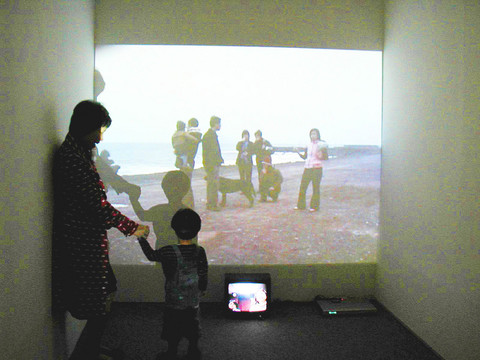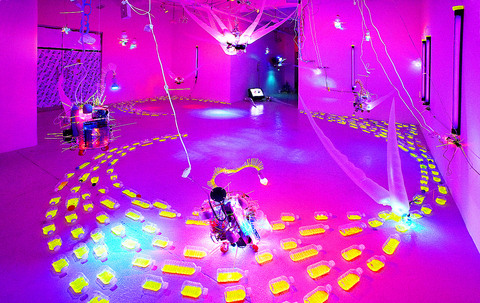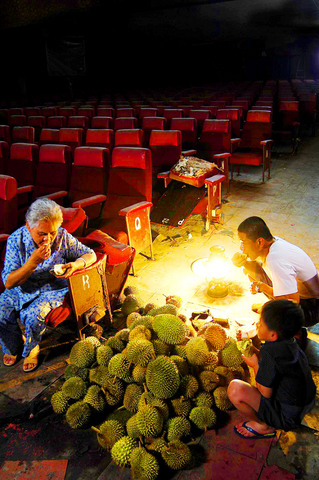Taiwan is not a utopia, or a dystopia. It's not a place. Diplomatically it has no space. Politically it does not exist. We can't even agree on its name.
Even so, its presence will be felt at the 52nd Venice Biennale in Italy next month, when six artists from the "nation without nationality" will be exhibiting their works.
The theme of the entry is Atopia and refers not only to the political position that Taiwan finds itself in, but also a 21st-century condition that applies to us all.

PHOTO: COURTESY OF ARTISTS
"Atopia refers to the situation of post-colonialism we are in. There has not been much time to become a country. Many other places are like this, nations without nationality," curator Hongjohn Lin (林宏璋) said yesterday at a press conference introducing Taiwan's Venice Biennale entry.
"Atopia" features work from the auteur Tsai Ming-liang (蔡明亮), photographer Lee Kuo-min (李國民), video director Tang Huang-chen (湯皇珍), bricoleur Huang Shih-chieh (黃世傑) and comic-book artist VIVA.
The range of artists chosen makes it a colorful as well as a challenging show that peers into the abyss to explore the concept of Taiwanese-ness.

PHOTO: COURTESY OF ARTISTS
Lin has borrowed the term atopia from the German sociologist Helmut Willke, who defines it as a non-place, or society without borders.
Globalization, multinational companies and the Internet are creating a world in which international markets, non-governmental organizations and multi-culturalism erase the relevance of nationhood.
Lin has adapted the term for his own purpose and localized it. The artist, academic and drummer said that Taiwan was an "atopian state par excellence."

PHOTO: COURTESY OF ARTISTS
It is not recognized as a state by most countries because of pressure from China, which claims it as its own. Even so, it has its own government and is a powerful economy.
Taiwan's identity is so amorphous it's name keeps changing, Lin said. When it competes in the Olympics it is called Chinese-Taipei. Officially it is the Republic of China, but this technically refers to the state formed in 1912 by Sun Yat-sen (孫逸仙), the "father of modern China."
Putting politics, sociology and names aside, Atopia captures the flavor of Taiwanese contemporary art in all its diversity.
Tsai Ming-liang's film installation Is It a Dream? is said to be "like a sculpture in time" and is set in a fading cinema in Malaysia, which refers to the golden age of flim and its current malaise. There is also a theme of displacement, which ties in with atopia.
Lee Kuo-min is a photographer who has documented disappearing lives, such as Treasure Hill and the Losheng Leprosarium, by taking pictures of people's living accommodation. They are intensely personal but also represent a contemporary reality.
Tang Huang-chen has explored the theme of personal memory in her video; while Huang Shih-chieh's bright technological inventions propose a vision of the future that is both humorous and slightly unsettling.
The comic artist VIVA explores the idea of copying other countries' culture and making it one's own. A series of cartoons (with translations by former Taipei Times reporter David Frazier) are memorable for their glocalized messages.
The Venice Biennale was first held in 1895 and is one of the world's major contemporary art exhibitions.
"Atopia" opens in the Taiwan Pavilion, at the Palazzo delle Prigioni in San Marco, Venice, Italy, from June 10 to Nov. 21. See www.labiennale.org.

Eric Finkelstein is a world record junkie. The American’s Guinness World Records include the largest flag mosaic made from table tennis balls, the longest table tennis serve and eating at the most Michelin-starred restaurants in 24 hours in New York. Many would probably share the opinion of Finkelstein’s sister when talking about his records: “You’re a lunatic.” But that’s not stopping him from his next big feat, and this time he is teaming up with his wife, Taiwanese native Jackie Cheng (鄭佳祺): visit and purchase a

April 7 to April 13 After spending over two years with the Republic of China (ROC) Army, A-Mei (阿美) boarded a ship in April 1947 bound for Taiwan. But instead of walking on board with his comrades, his roughly 5-tonne body was lifted using a cargo net. He wasn’t the only elephant; A-Lan (阿蘭) and A-Pei (阿沛) were also on board. The trio had been through hell since they’d been captured by the Japanese Army in Myanmar to transport supplies during World War II. The pachyderms were seized by the ROC New 1st Army’s 30th Division in January 1945, serving

The People’s Republic of China (PRC) last week offered us a glimpse of the violence it plans against Taiwan, with two days of blockade drills conducted around the nation and live-fire exercises not far away in the East China Sea. The PRC said it had practiced hitting “simulated targets of key ports and energy facilities.” Taiwan confirmed on Thursday that PRC Coast Guard ships were directed by the its Eastern Theater Command, meaning that they are assumed to be military assets in a confrontation. Because of this, the number of assets available to the PRC navy is far, far bigger

The 1990s were a turbulent time for the Chinese Nationalist Party’s (KMT) patronage factions. For a look at how they formed, check out the March 2 “Deep Dives.” In the boom years of the 1980s and 1990s the factions amassed fortunes from corruption, access to the levers of local government and prime access to property. They also moved into industries like construction and the gravel business, devastating river ecosystems while the governments they controlled looked the other way. By this period, the factions had largely carved out geographical feifdoms in the local jurisdictions the national KMT restrained them to. For example,